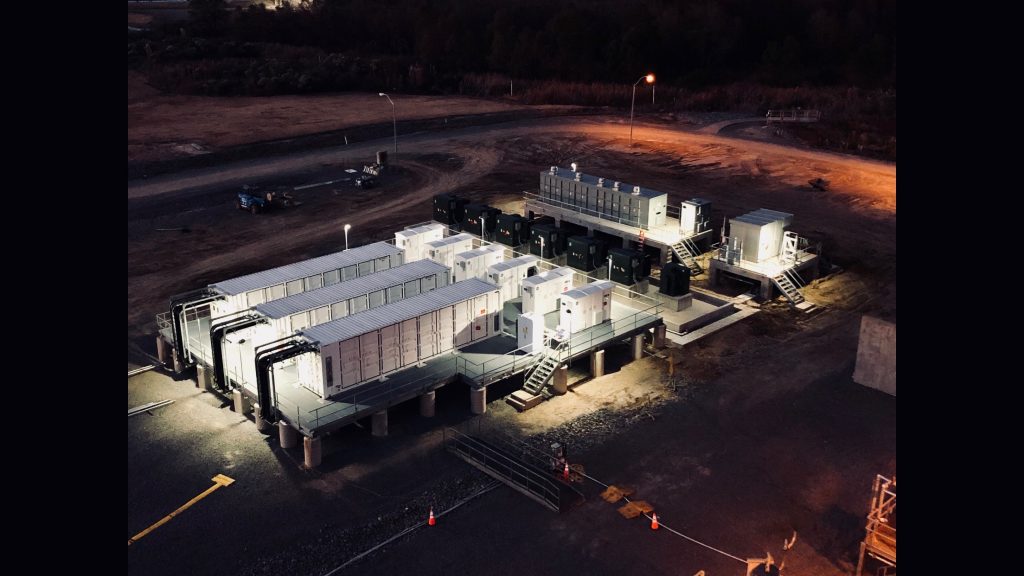
March 12, 2020

BACK IN BLACK
When a power outage occurs and the lights go out, every minute counts. Some disruptions can be significant enough to cause a power station to shut down. Such stations typically restart by drawing power from the grid. But what if the entire grid loses power due to a severe event — say, a hurricane? Then operators have to re-energize the grid carefully, beginning with a single generator, in a maneuver called a black start. Traditionally, black-start generators use gas or diesel. But advances in battery-storage technology are now enabling some utility-scale units to use batteries to get going again: a black start for the renewables age.
Restart me up: In December, GE unveiled a black-start battery-storage system at Entergy Louisiana’s Perryville Power Station, part of a network that serves 1.1 million customers in the state. Engineers have been chasing ways to store energy since the dawn of electricity, but it’s only in recent years that grid-scale batteries have emerged as major players — they can store energy generated by wind and solar, for instance, after the wind dies and the sun sets. In Louisiana, GE’s system — comprising 21,400 lithium-ion battery cells — stores enough energy to execute two back-to-back black starts (with juice to spare) before needing to be recharged. Prakash Chandra, Renewable Hybrids CEO at GE Renewable Energy, put it succinctly: “Achieving a black start with batteries is a very big deal.”
Read more here.
FAST FRIENDS
This week the magazine Fast Company released its annual list of most innovative companies. Clocking in at No. 2 in the energy sector? GE Renewable Energy, cited for “manufacturing the world’s most powerful offshore wind turbine.” That’d be the Haliade-X, a prototype of which generated its first electrons several months ago in the Netherlands. The nod from Fast Company is a high honor, but it’s far from the first accolade for this mighty machine: In December, Time magazine put the Haliade-X on its Best Inventions 2019 list.
Out for a spin: With help from the world’s longest turbine blades — each stretches to 107 meters — the Haliade-X’s rotor and 12-megawatt generator can capture and convert enough wind into electricity to supply 16,000 European homes. The machine is currently going through tests that’ll enable it to receive its type certificate, a permit that will allow GE to start supplying the Haliade-X to customers. They’re already lining up: The Danish offshore wind pioneer Ørsted picked the Haliade-X for two massive offshore wind farms in the United States, with capacity totaling 1,220 MW. The 3.6-gigawatt (GW) Dogger Bank installation also selected the technology: Located in the North Sea, it’s set to be the world’s largest offshore wind project. Apparently, the editors at Fast Company know a big deal when they see one.
The Haliade-X is in good company: GE Renewable Energy also has the Cypress, its largest onshore wind turbine. With a tower that soars up to 161 meters into the air, or roughly as tall as a medium-size New York skyscraper, it’s capable of generating enough electricity to power 5,000 European homes, thanks to a 158-meter rotor. That’s a lot of green electrons for countries, such as Turkey, whose renewable-energy operator Borusan EnBW Enerji ordered 27 Cypress wind turbines in 2019.
Click here for the Fast Company list of most innovative energy companies, and here for more on the Haliade-X.
BIOMASS BENEFITS
A new study by researchers at Michigan State University and Israel’s Ben-Gurion University of the Negev found that biomass fuels — those made from organic matter such as grasses — can “significantly mitigate global warming by reducing carbon.” Specifically, the researchers explored various crops as alternatives to petroleum for powering vehicles. Ben-Gurion’s Ilya Gelfand said, “Every crop we tested had a very significant mitigation capacity despite being grown on very different soils and under natural climate variability. These crops could provide a very significant portion of the decarbonization of U.S. light-duty vehicle transport to curb CO2 emissions and slow global warming.”
Full steam ahead: It’s not just in the transportation sector that biomass shows potential. In Japan, utility operators have turned to the alternative fuel as they seek ambitious targets for renewable energy. Recently, GE Steam Power signed a deal with Hitachi Zosen Corporation to design, manufacture and supply the main parts of a power plant that will burn plant-derived biomass to produce 50 megawatts of electricity for the country’s grid. The plant will burn palm kernel shells and wood pellets, but — says Sacha Parneix of GE Steam Power — the actual process of extracting the energy won’t be at all unfamiliar: “We have been at the leading edge of steam power technology for over a century. The fuel in the boiler may be different, and even carbon-neutral, but the process is the same.”
Learn more here about GE’s biomass plans in Japan, and click here for more on the new study.
COOLEST THINGS ON EARTH ?
1. Under Your Skin
Researchers funded by the Defense Department are studying whether an injectable under-the-skin biosensor can detect flu infection before symptoms start to show — and therefore slow or stop disease outbreaks.
2. Drilling Down On Disease
At Rice University, scientists are investigating ways to use molecule-sized drills to attack bad actors in the body, including cancer and drug-resistant bacteria cells.
3. Just The Vax
A team at the University of Texas at Austin developed a vaccine-delivery method that dissolves on the tongue like hard candy — which is what inspired it.
Read more here about this week’s Coolest Things on Earth.
— QUOTE OF THE DAY —
“Do the math and the equations, and you end up with a near-carbon-neutral process that also generates kilowatt-hours of electricity.”
— Sacha Parneix, chief commercial officer of GE’s Steam Power division
Quote: GE Reports. Image: Entergy.
ENJOY THIS NEWSLETTER?
Please send it to your friends and let them know they can subscribe here.




